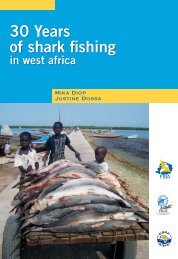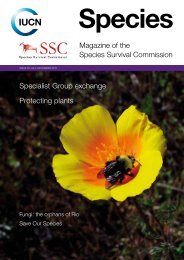Kyne & Simpfendorfer.. - Shark Specialist Group
Kyne & Simpfendorfer.. - Shark Specialist Group
Kyne & Simpfendorfer.. - Shark Specialist Group
You also want an ePaper? Increase the reach of your titles
YUMPU automatically turns print PDFs into web optimized ePapers that Google loves.
Gonzalez 2006). Daley et al. (2002) suggests that D. licha has a non-continuous reproductive<br />
cycle.<br />
Order Squatiniformes. Angelsharks.<br />
Family Squatinidae. Angelsharks.<br />
The angelsharks included in this report are all marginal deepwater species that occur on the<br />
shelf and upper slope. The deepest recorded is 500m for the sawback angelshark Squatina<br />
aculeata from the Atlantic and 494m for the African angelshark S. africana. Of the species<br />
included here two Australian endemics remain undescribed (Last and Stevens 1994) and are<br />
relatively poorly-known, as is S. africana and the Taiwan angelshark S. formosa.<br />
Reproductive parameters for the remaining outer shelf and upper slope squatinid sharks are<br />
summarized in Table 2.9.<br />
Squatinids are yolk-sac viviparous (Musick and Ellis 2005) and their reproductive potential is<br />
limited. All have small litter sizes and extended gestation periods with possible biennial<br />
reproductive cycles in at least some species. Litter sizes in the upper slope species range from<br />
2 to 12 and Bridge et al. (1998) suggested that gestation in S. tergocellata lasts 6–12 months<br />
with a probable biennial reproductive cycle, while Capapé et al. (2005) provided evidence for<br />
a ~12 month gestation in S. aculeata. A female breeding cycle of at least 2 years has been<br />
suggested for S. argentina (Vooren and Klippel 2005).<br />
Table 2.9. Reproductive biology of outer shelf and upper slope squatinid sharks. A litter size<br />
value in parentheses is the mean value.<br />
Species Location TL max<br />
(mm)<br />
Maturity (mm<br />
TL)<br />
Maturity<br />
%TL max<br />
Litter size<br />
Size at birth<br />
(mm TL)<br />
Reference<br />
Squatina<br />
aculeata<br />
Senegal, EC<br />
Atlantic and<br />
Tunisia,<br />
Mediterranean<br />
♀ 1750<br />
♂ 1520<br />
1370-1430<br />
1200-1220<br />
78-82<br />
79-80<br />
8-12 (11.1) 303-350 Capapé et al.<br />
(2005)<br />
Squatina<br />
argentina<br />
Southern<br />
Brazil, SW<br />
Atlantic<br />
♀ 1380<br />
♂ --<br />
~1200<br />
~1200<br />
87<br />
--<br />
7-11 -- Vooren &<br />
Klippel (2005)<br />
Squatina<br />
tergocellata<br />
Southern<br />
Australia,<br />
Eastern Indian<br />
♀ 1400<br />
♂ 1025<br />
1150-1250<br />
810-910<br />
82-89<br />
79-89<br />
2-9 (4.5) ~325-415 Bridge et al.<br />
(1998)<br />
Order Pristiophoriformes. Sawsharks.<br />
Family Pristiophoridae. Sawsharks.<br />
The deepwater sawsharks are poorly-known, with several species remaining undescribed. All<br />
species have relatively restricted distributions. Sawsharks are yolk-sac viviparous and Bass et<br />
al. (1975) reported a litter of seven embryos in a sixgill sawshark Pliotrema warreni, but<br />
noted that the female had apparently aborted several other embryos upon capture. Ovarian<br />
fecundity from a larger number of females was 7–17 (average 12.5) (Bass et al. 1975).<br />
Maturity is reached in females by ~1100mm TL and in males by ~830mm TL, representing<br />
81% and 74% of TL max reported by Bass et al. (1975), respectively. The species is more<br />
common on the shelf in some parts of its distribution (including possible shallower water<br />
80
















